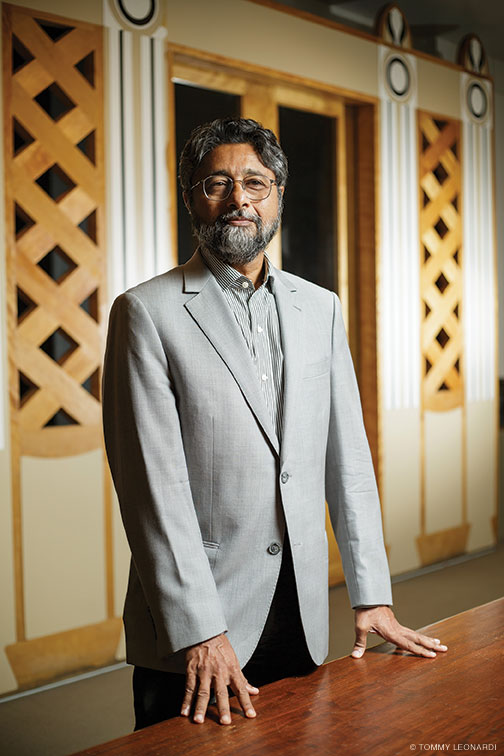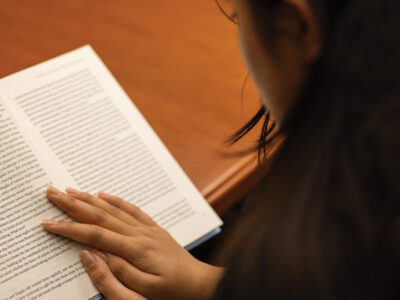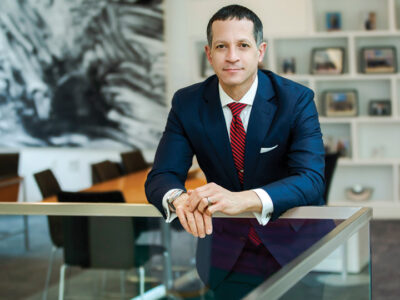
A new center delves into the neuroscience of aesthetics.
When we look at a face marked by a scar, burn, or other anomaly, are we likely to form a negative judgment about that person’s character? Why do we respond positively to a room with high ceilings and curving walls but tend to feel uncomfortable in tight, angular spaces? How is it that you gravitate toward the action painting of Jackson Pollock while I prefer the ordered geometry of Piet Mondrian?
Answering questions like these—and others involving how our brains respond to what we see—is the focus of the recently established Penn Center for Neuroaesthetics (PCfN), directed by Anjan Chatterjee M’85, the Frank A. and Gwladys H. Elliott Professor of Neurology; former chair of the department of neurology at Pennsylvania Hospital; and author of, among other books, The Aesthetic Brain: How We Evolved to Desire Beauty and Enjoy Art.
In the couple of decades that neuroaesthetics has been a recognized field of study within cognitive neuroscience, Chatterjee notes, it’s mostly been limited to teasing out the biological underpinnings of our reactions to the people, places, objects, and experiences (from listening to a musical composition to eating a Michelin-starred meal) that appeal to the senses. But that’s begun to change. “In the past few years, there’s been an interest in going beyond ideas of beauty to include elements like cultural considerations and ethical or moral consequences,” he says. “People respond to Game of Thrones, for instance, but with feelings of horror and danger and disgust. Why do such ‘unpleasant’ emotions also give us pleasure?”
Frankfurt’s Max Planck Institute for Empirical Aesthetics—which examines linkages between neuroscience and the appreciation of music and literature—and Goldsmiths, University of London—which offers a degree in the neuroaesthetics of creativity—cover related areas, but the Penn center is being touted as the first of its kind in the US, with a particular focus on visual aesthetics.
The time and the place are right, Chatterjee believes. PCfN adds another perspective to established entities like Penn’s Center for Cognitive Neuroscience and the Center for Neuroscience & Society, which explores the ethical, legal, and social aspects of neuroscience [“Are Better Brains Better?” Nov|Dec 2009]. “Penn has a well-developed expertise in cognitive neuroscience—there’s a kind of intellectual fervor about the field here that you don’t find in many other places,” Chatterjee says. “There’s a lot of constituencies here interested in this topic but no one has brought them all together.”
Though housed in the Perelman School of Medicine, PCfN is a distinctly interdisciplinary effort involving scholars from the Weitzman School of Design, Arts and Sciences, Wharton, and Engineering, as well as Penn Medicine. In addition to the center’s own team of staff and researchers, affiliated faculty range from Linton Whitaker, former chief of plastic surgery at HUP and the Children’s Hospital of Philadelphia, to Coren Apicella, an associate professor of psychology who studies the aesthetic experiences of the Hadza population in Tanzania. Outside collaborators include experts from Philadelphia institutions like the University of the Arts and the Barnes Foundation, and international scholars from Toronto, Copenhagen, Vienna, and London.
PCfN’s mission is twofold: to advance the study of the science of aesthetics and to consider how those findings can be applied in practical ways. Its current projects fall into three broad categories: beauty and morality, the built environment and its impact on our well-being, and the nature of why we create and appreciate art.
With regard to beauty and morality, for instance, researchers at the center are examining whether negative reactions to facial anomalies translate into behavior, and, if so, potential ways to minimize those biases. In a project related to the theme of the built environment’s impact on well-being, the center is assisting an architectural firm in the design of a residential facility in suburban Philadelphia for people with cognitive impairment. Chatterjee is hoping to incorporate research to help the architects design facilities that respond to the specific needs of this population.
Since patients with these conditions are unable to remember numbers, he’d like to implement a better method of wayfinding that will guide them back to their apartments. And to dissuade them from wandering off and possibly endangering themselves, he’d like to implement a solution that stops short of locking their doors. “What about opening their doors to an outside area where all of the paths bring them back to the same door?” he suggests. “The idea is to have their environment work for them, not the other way around.”
In addition to pursuing basic and translational research, PCfN will present courses, seminars, publications, and public workshops and lectures. Collaborations with museums and artists will also be an important component. Its inaugural artist-in-residence is Lucas Kelly, a Philadelphia-based artist whose installations address the nature and fragility of memory.
With support from the Sachs Program for Arts Innovation [“Gazetteer,” Jan|Feb 2017], Kelly “will work collaboratively with PCfN on the development of an art project addressing the ambiguity of and constructive nature of human memory,” according to the program’s website. “Through Kelly’s work in the PCfN lab, his engagement with multiple departments, and through the residency’s culminating exhibit, this collaboration will expose young neuroscientists, artists, and clinicians at Penn to the potential for true dialogue between the arts and sciences early in their studies.”
The center’s emphasis on the visual comes from both Chatterjee’s “personal interest and professional expertise,” he says. “Part of my research involves thinking about spatial perceptions, and so I’m drawn to someone like [the Late Middle Ages Italian painter] Giotto, who was remarkable as one of the first Western artists to situate people in space and break down compositions into volumes.” He cites 19th- and 20th-century artists Paul Cézanne (for his use of visual planes), Henri Matisse (for his mastery of ornamentation), and Pablo Picasso (for his toying with perspective), along with the contemporary sculptor James Turrell, whose medium is light, as other favorites.
For Chatterjee, architecture, movies, and dance also belong on the spectrum of arts connected to visual systems. Whereas literature and music are extended in time, he says, visual media are relatively static, confined to one moment. But when you toss art forms like dance and film into the mix, he says, “that changes everything.”
His view of the field’s future is similarly broad. While neuroaesthetics as a discipline has been mostly focused on attitudes toward beauty, there are “so many more nuanced aesthetic experiences to explore,” Chatterjee says. “There are experiences that come embedded with negative emotions. There are multimodal experiences that draw on two senses: Does a too-noisy restaurant adversely affect taste and your enjoyment of its food? There are questions involving other neural systems, like body movement: Is there a neurological reason for preferring a painting—the Pollock over the Mondrian—that has more motion?
“There is just so much low-hanging fruit waiting to be more closely examined.”
—JoAnn Greco




